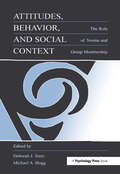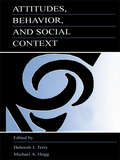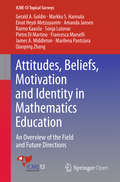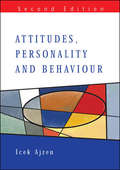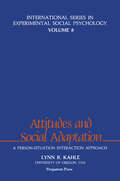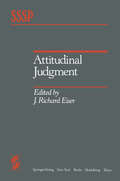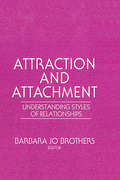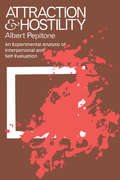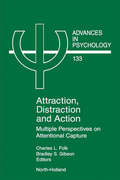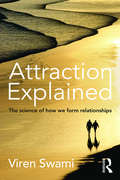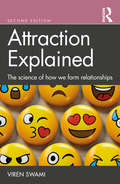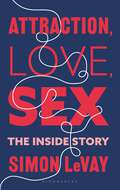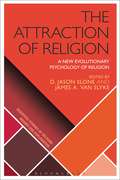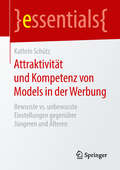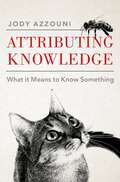- Table View
- List View
Attitudes, Behavior, and Social Context: The Role of Norms and Group Membership (Applied Social Research Series)
by Deborah J. Terry Michael A. HoggThe reasons why people do not always act in accord with their attitudes has been the focus of much social psychological research, as have the factors that account for why people change their attitudes and are persuaded by such influences as the media. There is strong support for the view that attitude-behavior consistency and persuasion cannot be well understood without reference to the wider social context in which we live. Although attitudes are held by individuals, they are social products to the extent that they are influenced by social norms and the expectations of others. This book brings together an international group of researchers discussing private and public selves and their interaction through attitudes and behavior. The effects of the social context on attitude-behavior relations and persuasion is the central theme of this book, which--in its combination of theoretical exposition, critique, and empirical research--should be of interest to both basic and applied social psychologists.
Attitudes, Behavior, and Social Context: The Role of Norms and Group Membership (Applied Social Research Series)
by Deborah J. Terry Michael A. HoggThe reasons why people do not always act in accord with their attitudes has been the focus of much social psychological research, as have the factors that account for why people change their attitudes and are persuaded by such influences as the media. There is strong support for the view that attitude-behavior consistency and persuasion cannot be well understood without reference to the wider social context in which we live. Although attitudes are held by individuals, they are social products to the extent that they are influenced by social norms and the expectations of others. This book brings together an international group of researchers discussing private and public selves and their interaction through attitudes and behavior. The effects of the social context on attitude-behavior relations and persuasion is the central theme of this book, which--in its combination of theoretical exposition, critique, and empirical research--should be of interest to both basic and applied social psychologists.
Attitudes, Beliefs, Motivation and Identity in Mathematics Education: An Overview of the Field and Future Directions (ICME-13 Topical Surveys)
by Markku S. Hannula Pietro Di Martino Marilena Pantziara Qiaoping Zhang Francesca Morselli Einat Heyd-Metzuyanim Sonja Lutovac Raimo Kaasila James A. Middleton Amanda Jansen Gerald A GoldinThis book records the state of the art in research on mathematics-related affect. It discusses the concepts and theories of mathematics-related affect along the lines of three dimensions. The first dimension identifies three broad categories of affect: motivation, emotions, and beliefs. The book contains one chapter on motivation, including discussions on how emotions and beliefs relate to motivation. There are two chapters that focus on beliefs and a chapter on attitude which cross-cuts through all these categories. The second dimension covers a rapidly fluctuating state to a more stable trait. All chapters in the book focus on trait-type affect and the chapter on motivation discusses both these dimensions. The third dimension regards the three main levels of theorizing: physiological (embodied), psychological (individual) and social. All chapters reflect that mathematics-related affect has mainly been studied using psychological theories.
Attitudes, Personality and Behaviour (UK Higher Education OUP Psychology Psychology)
by I AjzenWhy do people say one thing and do another? Why do people behave inconsistently from one situation to another?How do people translate their beliefs and feelings into actions? This thoroughly revised and updated edition describes why and how beliefs, attitudes and personality traits influence human behaviour. Building on the strengths of the previous edition, it covers recent developments in existing theories and details new theoretical approaches to the attitude-behaviour relationships. These novel developments provide insight into the predictability – and unpredictability – of human behaviour.The book examines:Recent innovations in the assessment of attitudes and personalityThe implications for prediction of behaviour of these innovationsDifferences between spontaneous and reasoned processesThe most recent research on the relations between intentions and behaviourWhile the book is written primarily for students and researchers in social, personality, and organizational psychology, it also has wide-reaching appeal to students, researchers and professionals in the fields of health and social welfare, marketing and consumer behaviour.
Attitudes & Social Adaptation: A Person-Situation Interaction Approach (International Series in Experimental Social Psychology #Volume 8)
by L. R. KahleAn important and interesting work which demonstrates the person-situation interaction theory of attitudes and attributes and shows how many of the principles of interaction or attribute research apply to attitude research (and vice versa). A new theory, social adaptation, is presented which attempts to account for the importance of attitudes and social cognition in human social behaviour, and applies Piaget's work on cognitive development to attitude research.
Attitudes to Psychological Stress Among Construction Professionals
by Alan PatchingThis book investigates attitudes to the avoidance and management of stress by project managers within the professional construction industry. The author argues that a widespread toxic culture belonging to the industry substantially contributes to industry stress, and analyses stress impacts among construction professionals, as well as the industry-specific causes of stress. The impacts and causes of stress of construction project managers are compared with those of other employees in the construction industry and with attitudes from across broader industry. The author concludes by establishing a leadership model for government and private organisations to effectively address a construction industry systemic problem head on.
Attitudinal Judgment (Springer Series in Social Psychology)
by J. RichardEiserDespite the central place that the study of attitudes has long held in social psycho logical research, the last decade or so has been relatively quiet as far as the de velopment of attitude theory has been concerned. If one looks back to the Yale studies on communication and persuasion in the 1950s, followed by the massive literature derived from cognitive dissonance theory and its alternatives, there may be a temptation to think that the well of researchable questions has run almost dry. The purpose of this book is to convince the reader that this is not the case. On the contrary, a new look at the concept of attitude offers the prospect of as rich and varied a range of questions as ever before. The term "new look" is an old one in social psychology. It was used 30 to 40 years ago as the designation for the school of thought which held that "basic" psychological processes such as perception, cognition, learning, and memory could be influenced by attitudes, motives, and values. There are still lessons to be learned from that period, and the new "new look" that is now emerging incorporates some of these same themes, albeit in the context of changing issues and emphases.
Attracted to Conflict: Dynamic Foundations of Destructive Social Relations (Peace Psychology Book Series)
by Robin R. Vallacher Peter T. Coleman Andrzej Nowak Lan Bui-Wrzosinska Larry Liebovitch Katharina Kugler Andrea BartoliConflict is inherent in virtually every aspect of human relations, from sport to parliamentary democracy, from fashion in the arts to paradigmatic challenges in the sciences, and from economic activity to intimate relationships. Yet, it can become among the most serious social problems humans face when it loses its constructive features and becomes protracted over time with no obvious means of resolution. This book addresses the subject of intractable social conflict from a new vantage point. Here, these types of conflict represent self-organizing phenomena, emerging quite naturally from the ongoing dynamics in human interaction at any scale—from the interpersonal to the international. Using the universal language and computational framework of nonlinear dynamical systems theory in combination with recent insights from social psychology, intractable conflict is understood as a system locked in special attractor states that constrain the thoughts and actions of the parties to the conflict. The emergence and maintenance of attractors for conflict can be described by means of formal models that incorporate the results of computer simulations, experiments, field research, and archival analyses. Multi-disciplinary research reflecting these approaches provides encouraging support for the dynamical systems perspective. Importantly, this text presents new views on conflict resolution. In contrast to traditional approaches that tend to focus on basic, short-lived cause-effect relations, the dynamical perspective emphasizes the temporal patterns and potential for emergence in destructive relations. Attractor deconstruction entails restoring complexity to a conflict scenario by isolating elements or changing the feedback loops among them. The creation of a latent attractor trades on the tendency toward multi-stability in dynamical systems and entails the consolidation of incongruent (positive) elements into a coherent structure. In the bifurcation scenario, factors are identified that can change the number and types of attractors in a conflict scenario. The implementation of these strategies may hold the key to unlocking intractable conflict, creating the potential for constructive social relations.
Attraction and Attachment: Understanding Styles of Relationships
by Barbara Jo BrothersHere is a fascinating exploration of the powerful forces of attachment and attraction that determine the formation and styles of couples’relationships. What factors attract one person to another? What determines whether or not a healthy relationship is formed? As therapists know, there is much in this world that passes for love but is really the result of leftover dependency needs and unresolved attachment issues. Attraction and Attachment: Understanding Styles of Relationships examines issues of attachment in relationships, discusses the validity of the concept of codependency as one aspect of attachment, and explores various aspects of attraction.The contributing authors consider some of the many styles of relationships that are called love and examine some of the basic sources of attraction. Attraction and Attachment includes an in-depth evaluation of the concept of codependency, a review of the literature on attraction, methods for achieving equilibrium in sexual intimacy, and some of Virginia Satir’s insights on fear and making changes. Just a few of the specific topics explored in these important chapters include: the relationship of childhood attachment experiences and successful long-term marriages the influence of therapists’implicit philosophies on treatment options and their effectiveness in therapy a review of biological, psychological, and social psychological literature on mate selection a definition of codependency a study of the link between codependency and depression couples’acceptance of alternative treatment formatsPsychiatrists, psychologists, and clinical social workers, as well as substance abuse counselors and pastoral counselors, can discover new insights on attraction and attachment in this provocative book. All mental health professionals can find new ways of looking at the foundational elements of relationships that are invaluable to them in their work with couples.
Attraction and Attachment: Understanding Styles of Relationships
by Barbara Jo BrothersHere is a fascinating exploration of the powerful forces of attachment and attraction that determine the formation and styles of couples’relationships. What factors attract one person to another? What determines whether or not a healthy relationship is formed? As therapists know, there is much in this world that passes for love but is really the result of leftover dependency needs and unresolved attachment issues. Attraction and Attachment: Understanding Styles of Relationships examines issues of attachment in relationships, discusses the validity of the concept of codependency as one aspect of attachment, and explores various aspects of attraction.The contributing authors consider some of the many styles of relationships that are called love and examine some of the basic sources of attraction. Attraction and Attachment includes an in-depth evaluation of the concept of codependency, a review of the literature on attraction, methods for achieving equilibrium in sexual intimacy, and some of Virginia Satir’s insights on fear and making changes. Just a few of the specific topics explored in these important chapters include: the relationship of childhood attachment experiences and successful long-term marriages the influence of therapists’implicit philosophies on treatment options and their effectiveness in therapy a review of biological, psychological, and social psychological literature on mate selection a definition of codependency a study of the link between codependency and depression couples’acceptance of alternative treatment formatsPsychiatrists, psychologists, and clinical social workers, as well as substance abuse counselors and pastoral counselors, can discover new insights on attraction and attachment in this provocative book. All mental health professionals can find new ways of looking at the foundational elements of relationships that are invaluable to them in their work with couples.
Attraction and Hostility: An Experimental Analysis of Interpersonal and Self Evaluation
by Anton PelinkaAttraction and hostility find expression in almost every variety of human relationship, and have consequently provided a central theme for social psychology since its beginnings. Yet attempts to conceptualize the diverse phenomena embraced in these terms have produced theories of such wide generality that they have little explanatory or predictive force. The object of the present study is to bring precision to a vast and sprawling area by setting limits and dimensions to the phenomena and investigating them experimentally on the basis of a series of hypotheses derived from a critical analysis of current conceptual approaches, including frustration, need-satisfaction, and dissonance models.The programme of experimental studies focuses on cognitive validation-a motivation to form and maintain subjectively valid evaluations of the self and the social environment-which is shown to be a common denominator of a number of attraction and hostility measures. The results throw light on reactions to boastfulness and to self-debasement; impressions of persons who are described by biased informants; effects of self-evaluation on competitiveness, and the projection of unfavourable characteristics.The interest of the study for social psychologists derives both from its theoretical integration of a wide range of behaviour and from its contribution to experimental design.
Attraction and Hostility: An Experimental Analysis of Interpersonal and Self Evaluation
by Albert PepitoneAttraction and hostility find expression in almost every variety of human relationship, and have consequently provided a central theme for social psychology since its beginnings. Yet attempts to conceptualize the diverse phenomena embraced in these terms have produced theories of such wide generality that they have little explanatory or predictive force. The object of the present study is to bring precision to a vast and sprawling area by setting limits and dimensions to the phenomena and investigating them experimentally on the basis of a series of hypotheses derived from a critical analysis of current conceptual approaches, including frustration, need-satisfaction, and dissonance models.The programme of experimental studies focuses on cognitive validation-a motivation to form and maintain subjectively valid evaluations of the self and the social environment-which is shown to be a common denominator of a number of attraction and hostility measures. The results throw light on reactions to boastfulness and to self-debasement; impressions of persons who are described by biased informants; effects of self-evaluation on competitiveness, and the projection of unfavourable characteristics.The interest of the study for social psychologists derives both from its theoretical integration of a wide range of behaviour and from its contribution to experimental design.
Attraction, Distraction and Action: Multiple Perspectives on Attentional Capture (ISSN #Volume 133)
by Charles Folk Bradley GibsonOver the last decade there has been a spate of research on the empirical phenomenon known as "attentional capture". Interest in capture can be attributed not only to its applied significance, but also to the implications of the phenomenon for theories of selective attention, as well as cognitive control in general. This growing interest, however, has also spawned a wide variety of experimental paradigms, empirical results, and theoretical perspectives. In June of 2000, 40 experimental psychologists converged on Villanova University for a conference and workshop on attentional capture. The intent was to provide an intimate forum for scientists from diverse perspectives and backgrounds, and using diverse methodologies to present their research on attentional capture and also engage in small group discussions on such key issues as the definition, measurement, and theoretical treatment of attention capture. This book presents a collection of chapters based on those presentations and discussions. Chapters are organized around areas such as neuroscience, visual cognition, developmental, individual differences and dynamical systems. The volume provides: a summary of the latest cutting edge research; an important compass for future research in this area; a useful survey of the field; contributions from internationally recognized experts in attention. Due to its exclusive focus on the topic of attentional capture the volume should make an excellent supplemental text or reference book for advanced undergraduate or graduate seminars in cognitive psychology and attention.
Attraction Explained: The science of how we form relationships
by Viren SwamiHow much does appearance matter in the formation of romantic relationships? Do nice guys always finish last? Does playing hard-to-get ever work? What really makes for a good chat-up line? When it comes to relationships, there’s no shortage of advice from self-help ‘experts’, pick-up artists, and glossy magazines. But modern-day myths of attraction often have no basis in fact or – worse – are rooted in little more than misogyny. In Attraction Explained, psychologist Viren Swami debunks these myths and draws on cutting-edge research to provide a ground-breaking and evidence-based account of relationship formation. At the core of this book is a very simple idea: there are no ‘laws of attraction’, no foolproof methods or strategies for getting someone to date you. But this isn’t to say that there’s nothing to be gained from studying attraction. Based on science rather than self-help clichés, Attraction Explained looks at how factors such as geography, appearance, personality, and similarity affect who we fall for and why.
Attraction Explained: The science of how we form relationships
by Viren SwamiWhen it comes to relationships, there’s no shortage of advice from self-help ‘experts’, pick-up artists, and glossy magazines. But modern-day myths of attraction often have no basis in fact or – worse – are rooted in little more than misogyny. Based on science rather than self-help clichés, psychologist Viren Swami debunks these myths and draws on cutting-edge research to provide a ground-breaking and evidence-based account of relationship formation. At the core of this book is a very simple idea: there are no ‘laws of attraction’, no fool-proof methods or strategies for getting someone to date you. But this isn’t to say that there’s nothing to be gained from studying attraction. Based on science rather than self-help clichés, Attraction Explained looks at how factors such as geography, physical appearance, reciprocity, and similarity affect who we fall for and why. With updated statistics, this second edition also includes new content on online dating, queer relationships, racism in dating, shyness, and individual differences. It remains an engaging and accessible introduction to attraction relationship formation for professionals, students, and general readers.
Attraction Explained: The science of how we form relationships
by Viren SwamiWhen it comes to relationships, there’s no shortage of advice from self-help ‘experts’, pick-up artists, and glossy magazines. But modern-day myths of attraction often have no basis in fact or – worse – are rooted in little more than misogyny. Based on science rather than self-help clichés, psychologist Viren Swami debunks these myths and draws on cutting-edge research to provide a ground-breaking and evidence-based account of relationship formation. At the core of this book is a very simple idea: there are no ‘laws of attraction’, no fool-proof methods or strategies for getting someone to date you. But this isn’t to say that there’s nothing to be gained from studying attraction. Based on science rather than self-help clichés, Attraction Explained looks at how factors such as geography, physical appearance, reciprocity, and similarity affect who we fall for and why. With updated statistics, this second edition also includes new content on online dating, queer relationships, racism in dating, shyness, and individual differences. It remains an engaging and accessible introduction to attraction relationship formation for professionals, students, and general readers.
Attraction Explained: The science of how we form relationships
by Viren SwamiHow much does appearance matter in the formation of romantic relationships? Do nice guys always finish last? Does playing hard-to-get ever work? What really makes for a good chat-up line? When it comes to relationships, there’s no shortage of advice from self-help ‘experts’, pick-up artists, and glossy magazines. But modern-day myths of attraction often have no basis in fact or – worse – are rooted in little more than misogyny. In Attraction Explained, psychologist Viren Swami debunks these myths and draws on cutting-edge research to provide a ground-breaking and evidence-based account of relationship formation. At the core of this book is a very simple idea: there are no ‘laws of attraction’, no foolproof methods or strategies for getting someone to date you. But this isn’t to say that there’s nothing to be gained from studying attraction. Based on science rather than self-help clichés, Attraction Explained looks at how factors such as geography, appearance, personality, and similarity affect who we fall for and why.
Attraction, Love, Sex: The Inside Story
by Simon LeVaySex, after hunger, may be the most powerful motivating force in our lives. It drives us to seek intimate contact with others and to form relationships that may be fleeting or lifelong, blissful or troubled. Yet many mysteries surround sex and sexuality: Why don't we reproduce by virgin birth? Why does so much of our sexual behavior have nothing to do with reproduction? Why isn't everyone heterosexual? How does the brain create sexual arousal? How do sexual kinks develop? Is porn harmful? What is the relationship between sex and love? In Attraction, Love, Sex, the renowned scholar Simon LeVay introduces readers to a memorable cast of researchers trying to answer these questions and many more. A biologist dredges a New Zealand lake for asexual mud snails. Psychologists measure whether eating a good meal changes a man's idea of female beauty. Physiologists probe orifices with miniature toilet plungers and place lovers in brain scanners. Geneticists reconstruct the sex crimes of Genghis Khan. Neuroscientists create mice whose sexual behavior can be switched on and off. A zoologist traps and releases 260,000 voles and launches a new science of love. LeVay distills vast expertise on the biology and psychology of sex into an engaging and easy-to-understand survey with scientific acumen, a critical eye and a sense of humor.
The Attraction of Religion: A New Evolutionary Psychology of Religion (Scientific Studies of Religion: Inquiry and Explanation)
by D. Jason Slone James A. Van SlykeReligion is an evolutionary puzzle. It involves beliefs in counterfactual worlds and engagement in costly rituals. Yet religion is widespread across all human cultures and eras. This begs the question, why are so many people attracted to religion? In The Attraction of Religion, essays by leading scholars in evolutionary psychology, anthropology, and religious studies demonstrate how religion may be related to evolutionary adaptations because religious commitments involve fitness-enhancing behaviours that promote reproduction, kinship, and social solidarity. Could it be that religion is wide-spread, at least in the modern world, because it helps to facilitate cooperative breeding? International contributors explore the philosophical and theoretical arguments for and against the use of costly signalling, sexual selection, and related theories to explain religion, and empirical findings that support or disconfirm such claims. The first book-length treatment that focuses specifically on costly signalling, sexual selection, and related evolutionary theories to explain religion, The Attraction of Religion will be an important contribution to the field and will be of interest to researchers in the fields of evolutionary psychology, religion and science, the psychology of religion, and anthropology of religion.
The Attraction of Religion: A New Evolutionary Psychology of Religion (Scientific Studies of Religion: Inquiry and Explanation)
by D. Jason Slone James A. SlykeReligion is an evolutionary puzzle. It involves beliefs in counterfactual worlds and engagement in costly rituals. Yet religion is widespread across all human cultures and eras. This begs the question, why are so many people attracted to religion? In The Attraction of Religion, essays by leading scholars in evolutionary psychology, anthropology, and religious studies demonstrate how religion may be related to evolutionary adaptations because religious commitments involve fitness-enhancing behaviours that promote reproduction, kinship, and social solidarity. Could it be that religion is wide-spread, at least in the modern world, because it helps to facilitate cooperative breeding? International contributors explore the philosophical and theoretical arguments for and against the use of costly signalling, sexual selection, and related theories to explain religion, and empirical findings that support or disconfirm such claims. The first book-length treatment that focuses specifically on costly signalling, sexual selection, and related evolutionary theories to explain religion, The Attraction of Religion will be an important contribution to the field and will be of interest to researchers in the fields of evolutionary psychology, religion and science, the psychology of religion, and anthropology of religion.
Attraktivität und Kompetenz von Models in der Werbung: Bewusste vs. unbewusste Einstellungen gegenüber Jüngeren und Älteren (essentials)
by Kathrin SchützDieses essential zeigt, wie sich neben jüngeren auch ältere Models gezielt in der Werbung einsetzen lassen und welche Altersgruppe für welche Produkte und Dienstleistungen geeignet ist. Passen jüngere Models generell besser zu Produkten für jüngere Konsumenten und gilt dies im Umkehrschluss auch für ältere Models? Möchten Jüngere und Ältere von Personen ihres Alters angesprochen werden oder kommt es auf die Passung zwischen Model und Produkt an? Die Autorin gibt einen Überblick über wissenschaftliche Erkenntnisse und untersucht aus Sicht der Jüngeren als auch der Älteren bewusste und unbewusste Einstellungen im Zusammenhang mit Altersstereotypen.
Attraktivität von Strafgefangenen: Warum Frauen sich zu Straftätern hingezogen fühlen (BestMasters)
by Désirée LabuschDésirée Labusch bietet eine vollständige Zusammenfassung der bisher bestehenden Untersuchungen über Frauen, die einen Partner wählen, der zum Zeitpunkt des Kennenlernens inhaftiert ist. Unter besonderer Berücksichtigung ihrer evolutionären Adaptivität und ihres austauschtheoretischen Nutzens werden die 13 wichtigsten, vor allem klinischen, psychoanalytischen, sozialisations- und persönlichkeitspsychologischen Erklärungsansätze sowohl inhaltlich als auch empirisch differenziert analysiert. Die Ergebnisse zeigen, dass es zwei verschiedene Typen von Strafgefangenen gibt, die von Frauen als attraktiv empfunden werden. Diese Frauen unterscheiden sich in ihren Persönlichkeitseigenschaften und Sozialisationserfahrungen.
Attraverso il microscopio: Neuroscienze e basi del ragionamento clinico (I blu)
by Davide SchifferIl libro prende le mosse dai pensieri di un giovane che alla maturità liceale si trova affascinato dalla cultura dei classici greco-latini, dai rudimenti filosofici e dall’impatto con le scienze fisiche e naturali. Il latino e i suoi naturalisti hanno suscitato un fervore verso la Botanica Sistematica che lo riporta a Linneo e quindi alla conoscenza del mondo naturale, all’esperienza della denominazione dell’esistente come conoscenza e quindi agli universali di Guglielmo d’Occam. La scelta della facoltà di Medicina fungerà da mediazione fra la filosofia, vista come via alla verità, e la biologia con il grande mistero dell’uomo nella sua dualità di mente/corpo. L’incontro con il microscopio aprirà la strada all’approfondimento della biologia, ma anche alla ricerca dei significati e delle interpretazioni del mondo. I meccanismi della percezione, visiva in particolare, nelle articolazioni della Gestaltpsychologie, e i suoi rapporti con il mondo interiore, sia quello della memoria esplicita che della memoria implicita, sono affrontati nell’esplorazione del mondo attraverso il microscopico e nella ricerca di una obiettività scientifica. Locke e Kant, Popper e Heidegger fanno da contraltare a Ramon y Cajal, Golgi, Kandel, Heisenberg, mentre la semiotica illumina e confonde sull’importanza del linguaggio per la conoscenza. Il segno e il suo riconoscimento si trasferiscono nella scienza attraverso l’inter-soggettività e il linguaggio appare come l’unico modo di penetrare l’esistente. Il libro si dilunga sull’origine di certe denominazioni in patologia tratte dalla vita quotidiana, sull’antropomorfismo spesso applicato agli oggetti del campo microscopico, sempre illustrati su base fenomenologica e psicologica.
Attributing Knowledge: What It Means to Know Something
by Jody AzzouniIn Attributing Knowledge, Jody Azzouni challenges philosophical conventions about what it means to know something. He argues that the restrictive conditions philosophers place on knowers only hold in special cases; knowledge can be attributed to babies, sophisticated animals (great apes, orcas), unsophisticated animals (bees), and machinery (drones, driverless cars). Azzouni also gives a fresh defense of fallibilism. Relying on lexical semantics and ordinary usage, he shows that there are no knowledge norms for assertion or action. He examines everyday cases of knowledge challenge and attribution to show many recent and popular epistemological positions are wrong. By providing a long-sought intelligible characterization of knowledge attribution, Azzouni explains why the concept has puzzled philosophers so long, and he solves longstanding and recent puzzles that have perplexed epistemologists--including the dogmatism paradox, Gettier puzzles, and the surprise-exam paradox. "This is a terrific book, full of surprises. For instance, Chapter 9 is full of points that are original, insightful, and useful in helping to resolve stale debates. I especially liked the points that we don't ordinarily describe someone as losing knowledge by gaining defeating evidence, that "knows" is vague and tri-scoped, that vagueness needn't be explained by appeal to precise metasemantic machinery, and that Williamson's anti-luminosity argument founders on the fact that knowledge doesn't require confidence. Bravo!" --Ram Neta, University of North Carolina, Chapel Hill Praise for Jody Azzouni's Ontology without Borders: "Azzouni offers a very strong drink, proposing that we do without central elements of what almost anyone would call logic or ontology. His arguments are serious and wide-ranging. If he's right, the reader will have learned something very important. If he's wrong, then the reader who figures out how he went wrong will also have learned something very important. Not every book has this feature." --Michael Gorman, The Catholic University of America
Attributing Knowledge: What It Means to Know Something
by Jody AzzouniIn Attributing Knowledge, Jody Azzouni challenges philosophical conventions about what it means to know something. He argues that the restrictive conditions philosophers place on knowers only hold in special cases; knowledge can be attributed to babies, sophisticated animals (great apes, orcas), unsophisticated animals (bees), and machinery (drones, driverless cars). Azzouni also gives a fresh defense of fallibilism. Relying on lexical semantics and ordinary usage, he shows that there are no knowledge norms for assertion or action. He examines everyday cases of knowledge challenge and attribution to show many recent and popular epistemological positions are wrong. By providing a long-sought intelligible characterization of knowledge attribution, Azzouni explains why the concept has puzzled philosophers so long, and he solves longstanding and recent puzzles that have perplexed epistemologists--including the dogmatism paradox, Gettier puzzles, and the surprise-exam paradox. "This is a terrific book, full of surprises. For instance, Chapter 9 is full of points that are original, insightful, and useful in helping to resolve stale debates. I especially liked the points that we don't ordinarily describe someone as losing knowledge by gaining defeating evidence, that "knows" is vague and tri-scoped, that vagueness needn't be explained by appeal to precise metasemantic machinery, and that Williamson's anti-luminosity argument founders on the fact that knowledge doesn't require confidence. Bravo!" --Ram Neta, University of North Carolina, Chapel Hill Praise for Jody Azzouni's Ontology without Borders: "Azzouni offers a very strong drink, proposing that we do without central elements of what almost anyone would call logic or ontology. His arguments are serious and wide-ranging. If he's right, the reader will have learned something very important. If he's wrong, then the reader who figures out how he went wrong will also have learned something very important. Not every book has this feature." --Michael Gorman, The Catholic University of America
